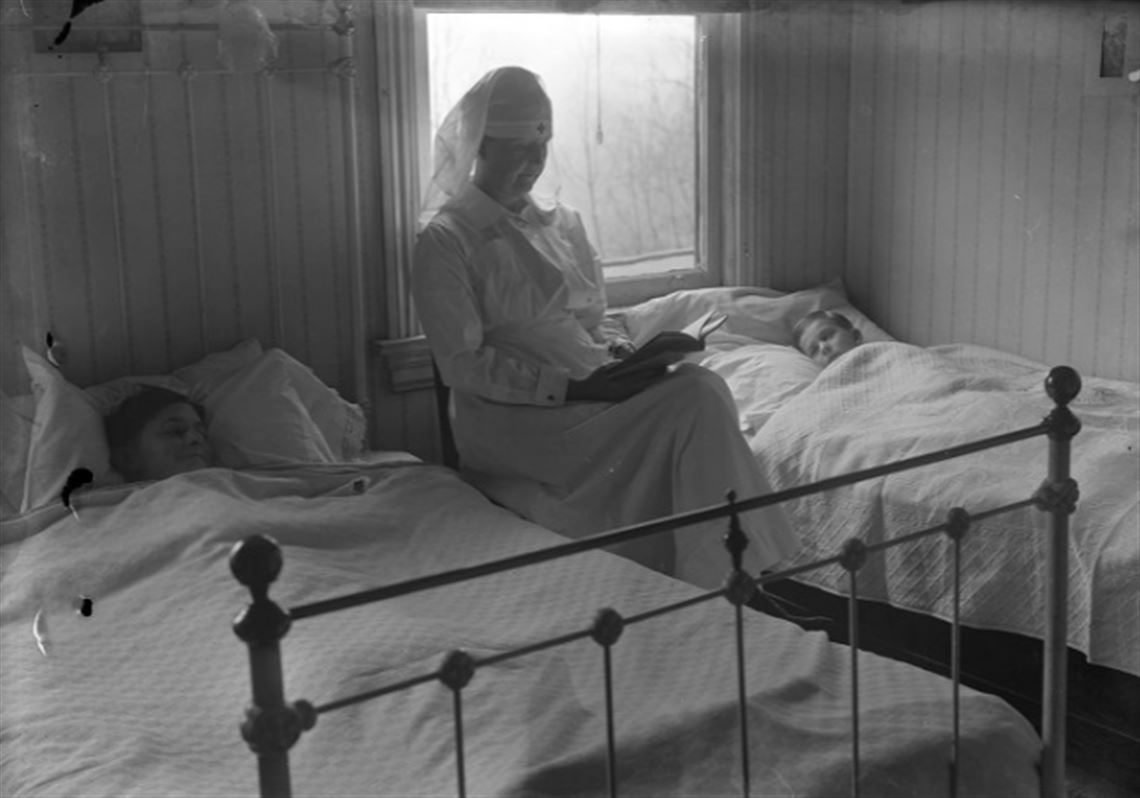If you were reading The Pittsburgh Press during the Spanish flu epidemic that killed 1,221 Pittsburghers during one October week of 1918, you might not have known you were living in the midst of a death spiral.
That stat about the deaths — and another about 1,245 Pittsburghers contracting the flu on a single day — came from a story on Page 6 in the Press the following April. By then, the epidemic was over. Under the headline “‘Flu’ Attacked 97 Percent of Population in One Part of the City,” the April 21 story said the 12th, 14th and 15th wards (largely Lincoln-Larimer, Squirrel Hill, Point Breeze, Greenfield and Hazelwood) were hit hardest.
The South Side and North Side got off relatively lightly, but “lighter” only meant hundreds of flu cases in those wards, while East End wards approached 2,000 cases apiece.
That’s an admittedly seat-of-the-pants, kitchen-table analysis gleaned from computer searches of the 1918 Press. But even allowing that its readership was a wartime populace living in a city where deaths and maiming in steel mills and factories were so commonplace they were treated as newspaper briefs, the matter-of-fact, below-the-fold coverage of the growing epidemic is striking.
The first mention I found was a June 3 story on Page 12 about a “mysterious plague” in Spain that had killed 700 people in 10 days. An Aug. 11 story on Page 45, “Spanish ‘Flu’ Spreads Over All of Europe,” said 600 had died in London in less than two months.
Finally, the flu story was bumped up to Page 2, or so I thought when I saw the headline “16 Dead in Boston From New Disease.” But that turned out to be an ad for Bulgarian Blood Tea that was both priming and playing off the growing fear.
By Oct. 8, less than two weeks shy of the epidemic’s peak in Pittsburgh, the pandemic was still treated only as a sidebar to America’s fight in World War I. Well below a banner front-page headline, “Huns Hard Pressed by Yanks,” was a single column that carried the headline, “Grip Cases in City Increase.” The story undersold the epidemic:
“Although the number of cases of Spanish influenza have increased and the death list is growing, there is still no reason for Pittsburgh to become panic-stricken over the situation, according to local health authorities.”
There were 409 new flu cases reported to the city health department from 5 p.m. the day before to 9 a.m. that day, but the afternoon paper assured readers in a misleading assessment that “the larger number come from the South Side, and the victims are said to be mostly foreign residents.”
About a fifth of the city’s residents were foreign-born then, and the Press wasn’t writing for them. It was one of seven English-language dailies in Pittsburgh, where one could also buy papers in German, Italian, Polish, Slovak and Hungarian. The Press knew its red-white-and-blue audience well enough that it ran what amounted to an editorial on that same Oct. 8 front page:
“Daddy Pitt today threw off his glasses, rolled up his sleeves and in an old-fashioned way spat on his hands. ... Darn Germany’s tricky peace proposal and the Spanish influenza restrictions! Neither one can stop us from lending our money to Uncle Sam.”
War fever trumped the real fever. Nobody knew the armistice ending the misnamed “war to end all wars” would be signed the following month. Across the state, Philadelphia had drawn 200,000 people to its Liberty Loan Parade on Sept. 28 and, by Oct. 1, there were 635 new cases of the flu there. Some 12,000 of the 47,000 reported cases there in the span of six weeks ended in death.
Did the nation underreact to the crisis in 1918? That’s dead certain. About 675,000 Americans died of the flu in the span of a year. The 50 million who died worldwide far outnumbered those killed in action in World War I.
We can look at the inadequacy of concern in 1918 with the benefit of hindsight. We’ll know soon enough if we’ve had enough foresight to stem the COVID-19 pandemic and allow us to have enough respirators and intensive-care beds to care for those whom the virus will surely strike.
Most of those who contract this virus will recover, and it won’t primarily kill those in the prime of their working lives the way the so-called Spanish flu did. Still, any holdouts who still think we’re overreacting might want to read up on how the 1918 flu spread. Or just know that the first mention of this “coronavirus” in the Post-Gazette came less than 10 weeks ago, in a Jan. 10 inside brief, “China IDs New Virus”:
The “mysterious pneumonialike illness … has sickened 59 people in Wuhan and caused a panic in the central Chinese region.”
Now 140 countries and all 50 states have had at least one case. The world has gotten smaller since 1918.
Brian O’Neill: boneill@post-gazette.com or 412-263-1947 or Twitter @brotheroneill.
First Published: March 19, 2020, 9:00 a.m.


















